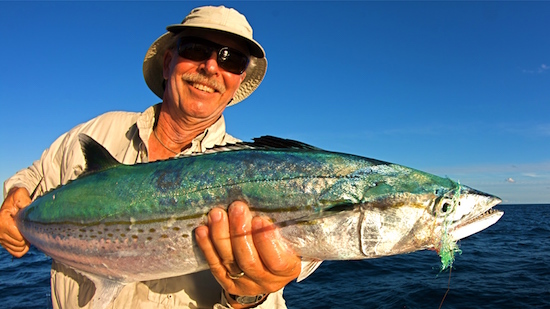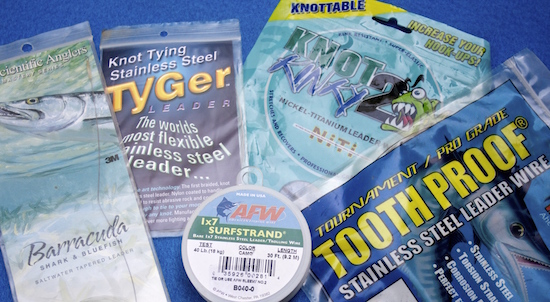Wire Leaders for Toothy Fish
If you fly fish in saltwater, at some point you will need to use wire leaders in order to catch fish. Bluefish, mackerel, barracuda, and sharks all require use of wire leaders. Or, you could donate lots of flies to the fish in question, especially bluefish and mackerel.
For a long time, leader wire came in three flavors, single strand stainless steel and plastic coated or uncoated stainless steel cable. Single strand users used a haywire twist to attach the fly to the wire. At the other end they had a choice of again using a haywire twist to attach a swivel, or using an Albright special to attach the rest of the leader, usually monofilament.
Single strand wire still works. Fly fishers generally use the coffee- or camo-colored wire. For smaller fish number two wire (+/-27 pound test) works well. If you’re going to use single-strand for big sharks you’ll want a thicker piece of wire.
The advantages of single-strand wire are that it’s inexpensive and relatively thin. It kinks though, and it breaks where those kinks form. Because it kinks, for those big sharks cable is usually a better choice. If, like me, you don’t use single-strand very often, making a decent haywire twist is slow and hard to do. Making those twists well takes practice.
Seven-strand, plastic-coated stainless steel cable doesn’t kink. You can attach it to the fly with either a snell (you’ll have to tie the fly to accommodate this), with a figure-eight knot, or with the melt-the-plastic knot. To do this last, after putting the end of the wire through the eye of the hook, wrap the tag tightly around the main piece of wire five times, then loosely a few more. Use a cigarette lighter to heat the wraps just until the plastic starts to melt. Then use a wire cutter to remove the tag.
Plastic coated cable has some disadvantages. It’s more visible than monofilament or single strand wire, fish teeth or abrasion can shred the nylon coating, allowing saltwater to get inside the nylon coating and cause corrosion over a period of time.
Uncoated forty-nine strand stainless steel cable is still the choice for most big game fishing. I don’t know how many fly fishers are big game fishing, but it can’t be very many. This product must be rinsed with freshwater after use to slow corrosion.
A few years back a new type of plastic coated cable appeared on the market, sold under the names of Surflon and Tyger Wire. These were the first stainless steel knottable leaders for toothy fish. You can tie knots with them, using the same knots you use with nylon or fluorocarbon. They are wonderful products for someone who doesn’t need wire very often, although I would be suspicious of their use in big-game applications.
Needless to say, they were more expensive than other products available at the time they were introduced.
I carried some Tyger Wire around for years without using it. On a recent trip to the Florida Keys we ended up fishing for cero mackerel. My having the Tyger Wire was the only reason we caught any fish.
Recently, a new wire leader product has appeared, made from titanium alloy. This new leader wire stretches and recovers to set hooks and prevent bite-offs. You can tie titanium wire to hooks and line using the Clinch and Albright Knots. Two manufacturers of this product are knot2kinky and American Fishing Wire. I haven’t used this product yet, but I am looking forward to doing so.
So, if you use lots of wire leaders you’ll probably want plastic coated cable or single-strand wire. If your use is occasional, a convenience of a tie-able product probably offsets its higher costs.
Copyright © John A. Kumiski 2022. It is illegal to reproduce or distribute this work in any manner or medium without written permission from the author, John A. Kumiski, 284 Clearview Road, Chuluota, FL 32766 (407) 977-5207.


